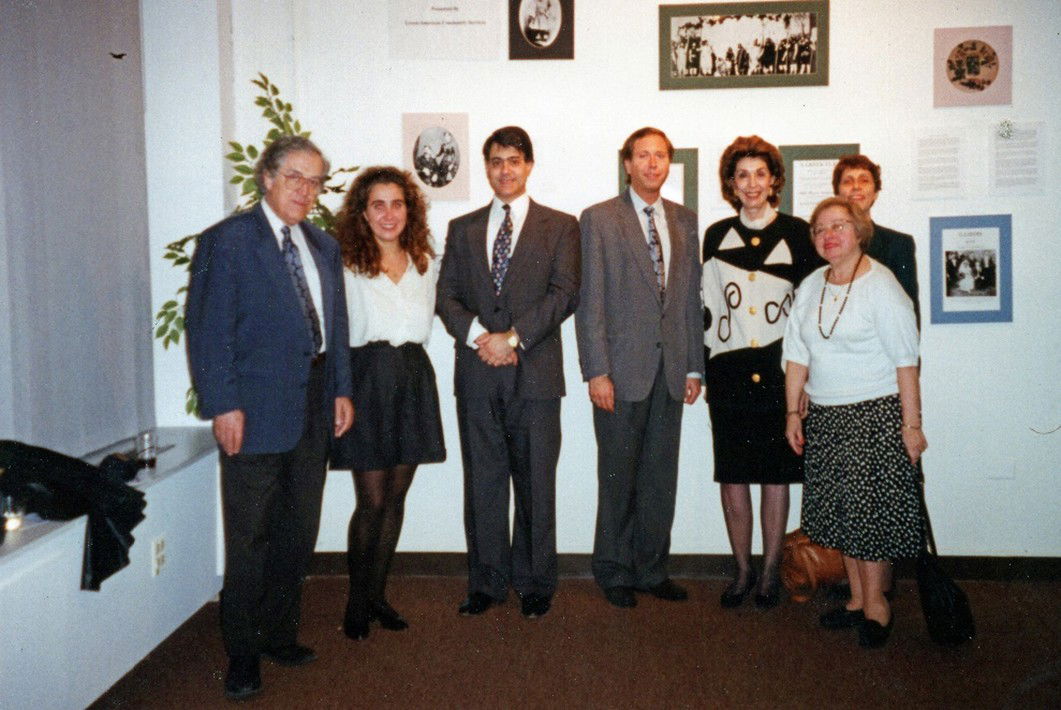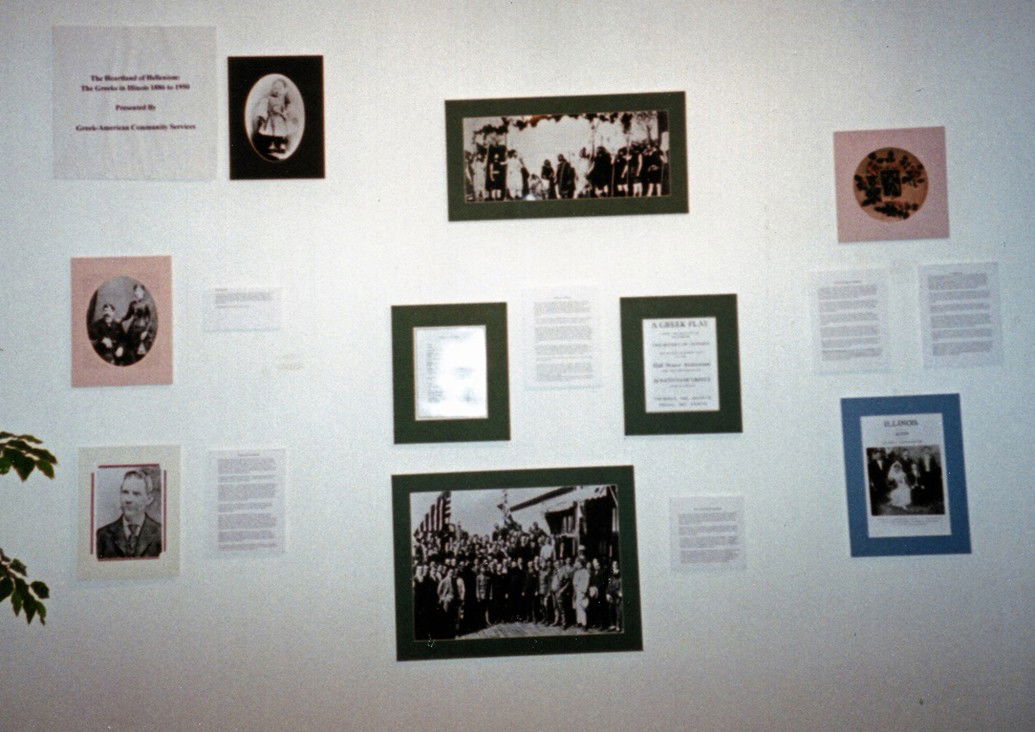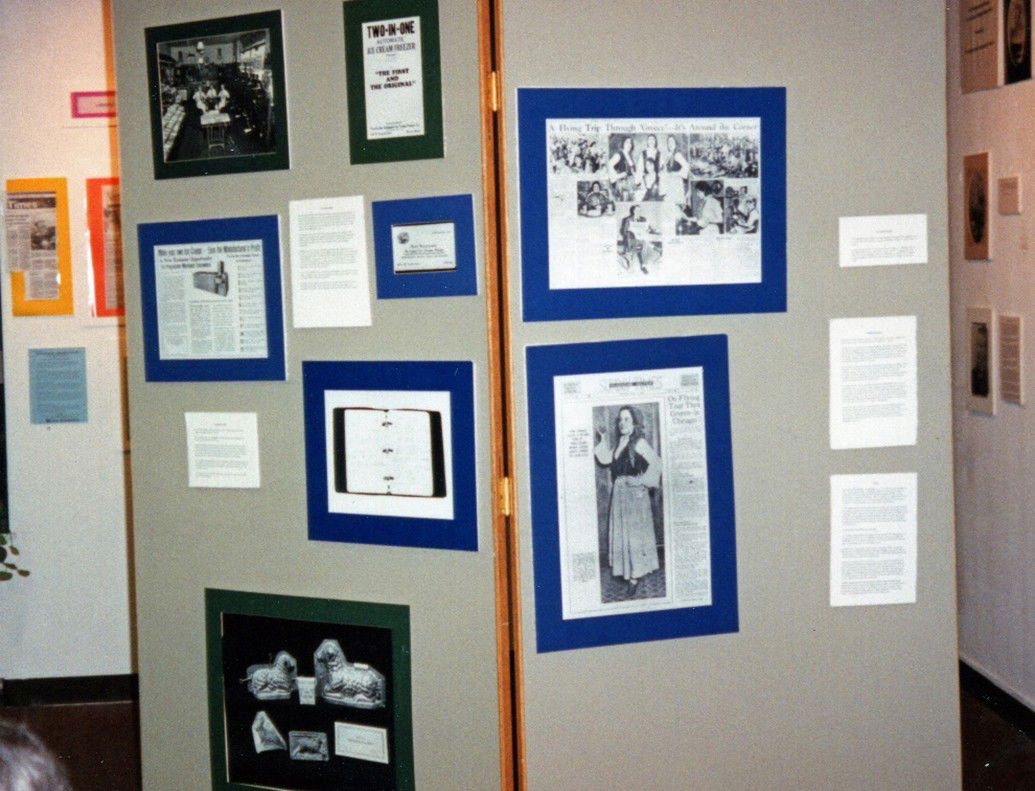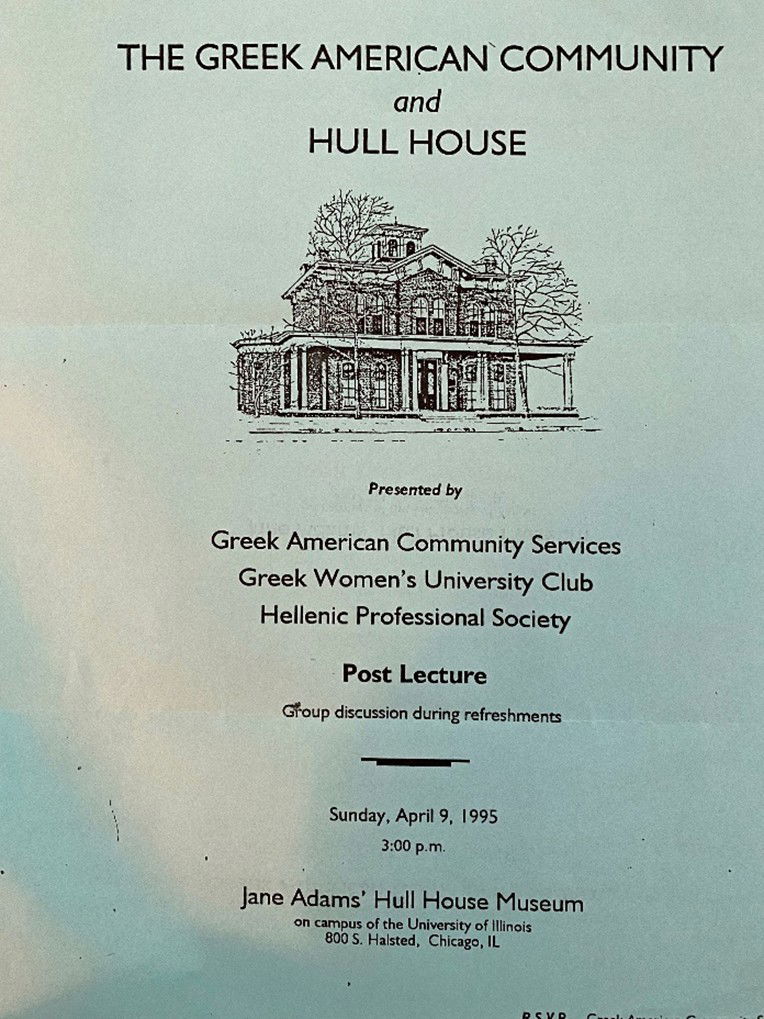'O Cosmos': The Private Lives and Public Celebrations of the Greeks in Illinois
From Working to Preserve Our Heritage: The Incredible Legacy of Greek-American Community Services
"The final Illinois Humanities Council grant GACS applied for was different from those of the past. This endeavor envisioned a traveling museum exhibit chronicling the Greek experience in Illinois. Entitled, 'O Cosmos: The Private Lives and Public Celebrations of the Greeks in Illinois from 1880 to 1990,' it involved the creation of a 26-panel exhibit that would be displayed at various locations throughout the state along with a concurrent distinguished lecture series addressing the overarching themes of the exhibit.
Although we had a track record for producing high-quality programming through our grants from the Illinois Humanities Council and had mastered the statewide lecture series format, we had never attempted to create a museum exhibition, especially one that would travel throughout the state.
With the help of the CAP Advisory Committee, GACS crafted a proposal that incorporated an exhibit that would travel the state for two years. In addition to research, this project involved the physical construction of the exhibit as well as coordinating logistics such as shipping for a statewide exhibition. A series of lectures related to the exhibit were also planned.
Elaine was the project director while Steve Frangos served as a primary grant writer and principal researcher. Steve, whose father owned a construction business in the Grayslake area, handled the construction of the wooden frame and structure as well as preparing the panels for mounting. He wrote most of the labels describing the photos and their context within the overall theme.
The IHC grant application explained the panel themes in this way:
Each of the four time periods in the exhibition itself is composed of four topical areas. The recurring themes of the exhibition are, in this fashion, extended and enlarged over the sweep of time Greeks have lived in Illinois.
Public Events: Images Offered
This group of panels will present and analyze the public presentations that Greeks offered as emblematic of themselves. How much was true and how much processed will be presented. Still, it should be noted that after a period of time, the distinctions began to get blurred even for the Greeks. Sometimes the constructed images became the only reality later generations would know.
In the realms of foreign politics, and issues involving social work projects, Greeks reveal a sophistication that was born out of their overseas experiences and extensive participation in the era’s American labor movement.
Private Life
There were settings or occasions where the Greeks could share their true sense and sensibilities without filtering them through the American environment around them. These included the home, the nuclear or extended family, the extensive but now largely forgotten bachelor groups, the regional societies, and eventually elaborate and exclusive social groups based on economic standing.
Classic Greek-American: The Arts and the Greek Muse
The life Greeks experienced in America was the subject of dramas, comedy records, ksenithia newspaper stories, radio programs, literature, dance performances, musical reviews, painting, and even the puppet tradition known as Karagiozis.
The Greeks used art (and continue to use it) as a means to define and address their life in Illinois. The panels in this category will present these genres, performances, and the artists who offered these interpretations to the community.
Observers Observed
Who were the American researchers or reporters on the Greeks in Illinois? How did these individuals describe the Greeks? How can we, from our vantage point in history, see the hidden agendas, and the implicit ideological stance, of these individuals? The Greeks were aware they were being studied. The Greeks very often used these researchers for their own ends. Manipulating these outsiders by providing them with specific information. How all this came about will be discussed in this panel.
The period themes were:
1886 – 1915 Paroika: The Colony Begins
In 1886, when the first 3,000 Greek men and youths arrived in Chicago they came as temporary workers, intent on returning to Greece as soon as their fortunes were made. When did the Greek laborer in America become an immigrant rather than a temporary worker? Politics in the Balkans and labor battles dominated the attention of the young men. Massive public demonstrations in Chicago by Greeks in 1897 and para-military training on the grounds of Hull House frightened Americans across the country.
The Greeks did not see themselves as immigrants. For centuries Greeks had worked throughout the Ottoman Empire, Europe, North Africa, and the Middle East only to return eventually to their village of birth. A song genre called Ksenithia e.g. literally ‘the strange land’ grew out of this out-migration. The diaspora, e.g. the scattering, as in the scattering of seeds, is how many of these migrant workers looked at and referred to as the scattered colonies of Greeks laboring in the ksenithia. What many American scholars saw as immigrants were a people who saw themselves as temporary sojourners with a long history of colonies across the world.
The social networks that are used by the Greeks in Illinois resemble those that evolved over the centuries-by earlier Greek laborers in Europe, the Middle East, across the continent of Africa, and elsewhere. In the very first years of the Greeks arriving in massive waves in Illinois, they begin to establish themselves, often, in the most rural of communities. None of this is even suspected for a moment by the Americans who only ‘see’ foreigners.
1915-1929 Diaspora: ‘Greek Town’ in Chicago
Once a majority of the Greeks in Illinois took the position that their stay in America was long-term and/or permanent, they sought to re-create their society and culture in the towns and prairies of Illinois. This active formation and perpetuation of Greek society and culture found expression through a number of avenues.
While it is the establishment of churches throughout Illinois; that is today often thought to be the first priority of an 'immigrant' community’s agenda, it was only one element of a wider program of action. Chicago is the location for a series of firsts in Greek publications: the first history book, the first poetry book, the first national magazine, and so on. The establishment of Greek schools, the availability of mail-order catalogues written in Greek (but for a whole array of materials from America and around the world), and the appearance of business directories and guidebooks document an awareness about the world that the Americans never suspected. From virtually the moment of their arrival in Illinois, Greeks were attuned to developing themselves, their community, and a competitive business edge through what we would call today, media resources. This was something that even later historians have failed to note.
Greeks were in touch with the wider world through other media forms. Live entertainment in the forms of record companies, drama troupes, and nightclubs abounded everywhere within the community. The Chicago Greek community was recognized as a key location in the worldwide network of Greek entertainment clubs. The major role the Chicago Greeks played as managers and owners of American entertainment in the forms of Taxi Dance Halls, Vaudeville Houses, and movie theaters is glossed over in most historical accounts of Illinois. How the skills and business connections of the Greek entertainment scene helped the Greek managers/owners of strictly 'American' entertainment will be explored. How all these social and cultural forms are themselves based on experiences and models developed over the long period of Turkokratia or the rule of the Greeks by the Ottoman Empire is kept from Americans. The development in public of a distinctly Greek identity (that is distinct from all other Balkan cultures) is intense.
3. 1929-1956 Kinotis: The Passage of Identity
The unintended consequence of the 1922-1924 Immigration Quotas Act was the development of a uniquely American-Greek society and culture, unlike any other diaspora community in the world. The birth of children to immigrants, their life in America, and World War II broadly outline the events of this period. In the late 1940s early 1950s community leadership slowly but inevitably passed from the immigrant generation to their American-born children.
Still, the sojourn in America was never fully accepted. From the late 1920s to just before World War II Greeks took extended trips back to Greece. Within the 1930s, trips back to Greece became a virtual rage in the community. Every family that could afford the trip, and many who really couldn’t, returned to their villages. The thought even then was maybe, just maybe, they would repatriate. Commercial records of the period provide us today with the Greek’s realization that this was impossible.
1956-1990: Patridha: The Many Ways of Being Greek
The Search for Alexander Exhibition, the ongoing political efforts directed at Cyprus, and the church festival are the public personas self-stressed by the Greek-American establishment. What this same group is anxious to downplay at every opportunity is the ongoing clash of identities among the present-day Greeks in Illinois. These unending conflicts are not simply between the American-born and the recent immigrants but also along sharply defined social class distinctions.
With new immigration from Greece dropping off in the 1980s, the community is once again entering an era similar to the post-1922 Immigration Quota period. Social life and events have grown. Still, there are fewer arenas where the various types of persons who call themselves Greek meet. Even church parishes have achieved specific social, economic, and cultural forms that mark them as belonging to one or another of these distinct subgroups.
The thirtysomething generation, born in America or born in Greece, seems to cut across all these lines of different clusters of Greeks, unlike any other subgroup in Greek American history. Where these intra-community distinctions are drawn, what are the specific issues keeping the groups apart, and what may be the eventual outcome will be surveyed in this final group of panels.
The exhibit included photos and recollections highlighting the evolution of the Greek community in Illinois including:
- A photo of Georgia Bitzis Pooley and her family. They were the first Greek family to settle in Illinois in 1885.
- A panel entitled 'Vlasia Remembered' describes marriage traditions within Greek immigrant households including picture brides and dowries. Death photographs are also explored, all related to a rural Greek village named Vlasia.
- A playbill and photo of Greek immigrant children performing the Return of Odysseus in the Hull House Auditorium at the corner of Polk and Halsted in 1899. The playbill states that the play is performed by 'Natives of Greece Living in Chicago.'
- A rare photo of a 1917-1918 U.S. Savings Bond Drive to raise money for World War I that was organized by Jane Addams at Hull House with the help of young Greeks who attended Hull House.
- A panel of family photographs donated by John Rassogianis that depicted his father and uncles (Constantine, Alex, and George) in Alex’s Sweet Shop, their Berwyn, Illinois candy store, circa the 1930s, along with a photo of handmade chocolate lambs made for Greek Easter. There were advertisements for the 'Two in One Ice Cream Freezer' and St. Louis Ice Cream Parlor in Chicago, also owned by John’s family.
- A photo of an early 78-record by the Elliopoulos Brothers recorded in Chicago at the turn of the century.
- A panel describing the participation of Greek Americans in Chicago’s World Fair includes a photo of a Chicago Sun-Times article entitled 'A Flying Trip Through Greece – It’s Around the Corner.'"

Opening night of the O Cosmos exhibition at the Hellenic Museum and Cultural Center. Pictured (L-R): Dr. Theodosis Kioutas, Athanasia Papadopoulos, Dr. Peter Chioros, John Psiharis, Irene Antoniou, Evangeline Mistaras, and Elaine Thomopoulos. Circa 1994. John Psiharis collection.


The “Heartland of Hellenism: Greeks in Illinois 1886-1950” exhibit on display at the Hellenic Museum & Cultural Center. Top: The first three panels of the exhibit displayed side-by-side on a wall. Bottom: (L) Photos from the Rassogianis family candy store. (R): A Chicago Sun Times article on Greeks at the Chicago World’s Fair. Circa 1994. Photos by John Rassogianis. John Psiharis collection.

“The Greek American Community and Hull House,” lecture flyer. April 9, 1995. Elaine Thomopoulos collection.